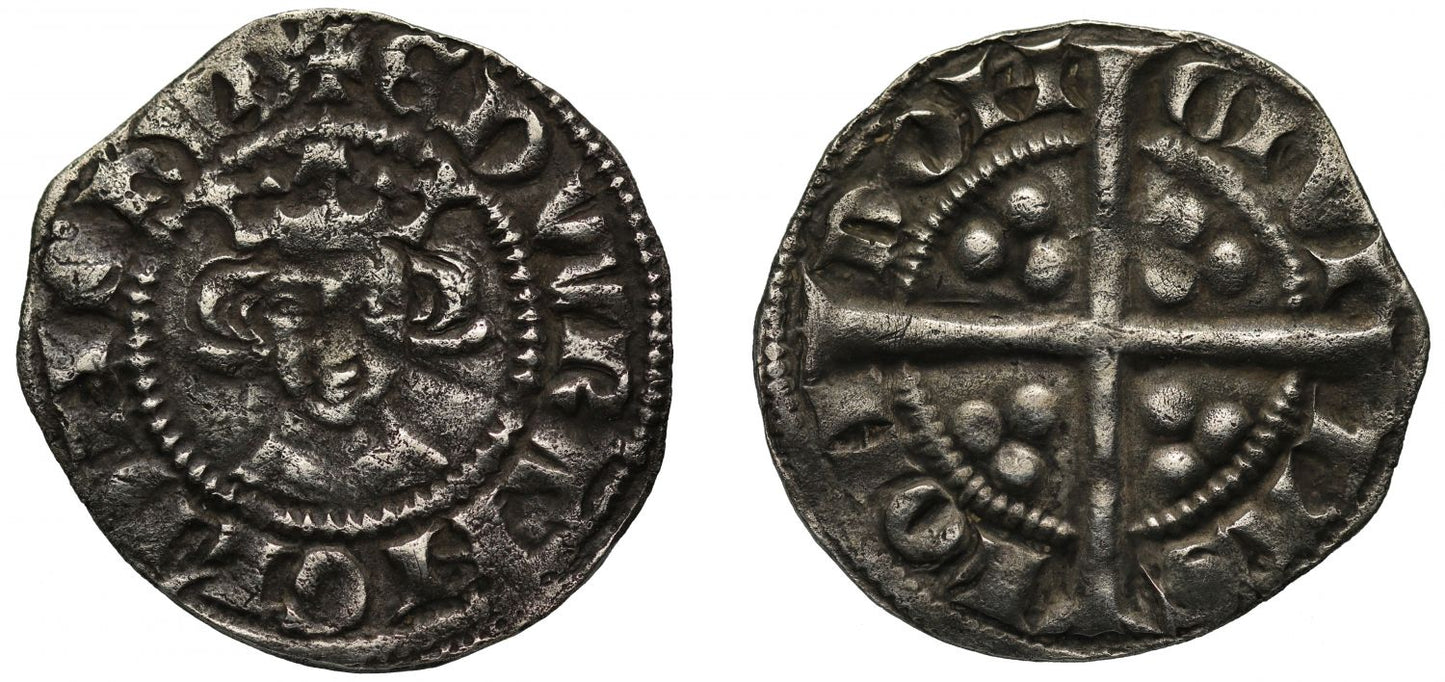FAQs
What makes a coin valuable?
I have coins to sell, what’s the next step?
How will my purchases be shipped?
What happens if I’m not entirely happy with my purchase?
Edward I long cross Penny, type 8b, London Mint
Edward I (1272-1307), silver long cross Penny, class 8b (1294-99), London mint, facing crowned head with wide neck, legend and beaded border surrounding, +EDW R ANGL DNS hYB, rev. long cross pattee, tri-pellets in inner angles, legend and beaded border surrounding, CIVI TAS LON DON, weight 1.32g (SCBI 39:332 North; N.1034/2; S.1406). Toned with die clash, good very fine and rare.
The Latin legends translate as "Edward King of England, Lord of Ireland" on the obverse and "City of London" on the reverse.
Edward son of Henry III and Eleanor of Proveance was born in June 1239 at the Palace of Westminster and was known as The Lord Edward whilst his Father was King. As a young adult he became involved in the political struggles of the Baronial rebellions and briefly sided with their reform in 1259 and supported the Provisions of Oxford. Edward later reconciled with his Father remaining loyal through the Second Barons War and was held hostage after the Battle of Lewes but later escaped. He went on to defeat Simon de Montfort at the Battel of Evesham in 1265 and within two years the rebellious barons were finished and peace once again reigned. Edward joined the Ninth Crusade to the Holy Land and it was on his way back in 1272 that he received news that Henry III had died on 20th November 1272. Edward Longshanks as he now became known due to his tall stature believed to be 6 foot 2 inches, took a leisurely return to England and was coronated on the 19th August 1274 at Westminster Abbey. It was not long till he had to suppress a rebellion in Wales in 1276-77 and again in 1282-83 which culminated in a full conquest with a series of castles built and English rule firmly in place. Edward continued to reform administration and common law with feudal liberties and then set his sights on Scotland claiming feudal suzerainty leading to war which continued after Edward's death though he was almost victorious on several occasions and became known as The Hammer of the Scots. Edward also became involved in war with France as a Scotch ally against Philip IV who confiscated the Duchy of Gascony, though Edward did recover it. The cost of these actions was heavy taxation for all and when he died in 1307 his son Edward II inherited conflict and strife.
Edward I was married twice, first in 1254 to Eleanor of Castile who bore him fourteen children and possibly two more as a number did not live to adulthood and only the one son Edward outlived his Father to become the next King. Eleanor died aged around 48 on 28th November 1290 and is buried in Westminster Abbey. Edward went on to marry Margaret of France in 1299 who bore him two sons and a daughter and was some 40 years his junior. Edward died whilst campaigning in the north on the morning of 7th July 1307 at Burgh by Sands in Cumberland suffering from dysentery, and he was buried at Westminster Abbey on 27th October of that year.
Capital City London upon the River Thames following Roman occupation, minted some of the earliest Saxon coins with gold Thrymsas and silver denarii with a "Londuniu" signature. Mercian Kings beginning with Offa minted coins there, but the first coin to actually say City of London upon it is the unique Ludica portrait Penny that was found in 2016, followed by subsequent coins of Ecgberht. In 871 the Danes wintered in London for the first time but was King Alfred of Wessex who settled and fortified the capital circa 880 to resist further invasions. Edward the Elder incorporated the City in Wessex in 911 and it resisted a major attack in the reign of Aethelred II in 1009. However, London submitted to the Danish Swein in 1013, but three years later the citizens accepted Eadmund Ironside as King and resisted a siege by Canute.
Later unsettled times occurred in the anarchy period of the reign of King Stephen, remaining loyal to the King except for a few months in 1141 when Empress Matilda was admitted but within a short time expelled. Coinage activity here has been mostly constant throughout history from the Romans until the reign of our current Queen and only moving out to Wales from 1969.
Provenance:
Ex Collection of an English Doctor part III, Sovereign Rarities fixed price list online August 2022.
FAQs
What makes a coin valuable?
I have coins to sell, what’s the next step?
How will my purchases be shipped?
What happens if I’m not entirely happy with my purchase?













